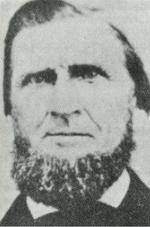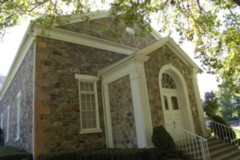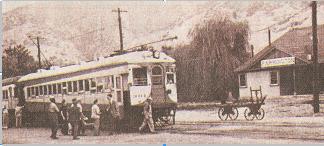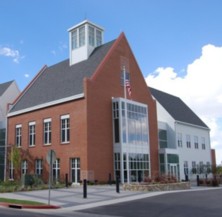

|
The first documented settlement in Farmington City by non-native peoples occurred in 1847, shortly after the Mormon pioneers arrived in Salt Lake City. Hector Haight, know as the father of Farmington, was delegated to winter cattle herds in the area in 1847-8. Several other families soon followed and built log cabins, usually along the streams coming down from the mountains. The settlement was named Farmington in 1852 and it became the county seat for the newly designated Davis County. The town was platted in 1853 and laid out in a narrow version of a Momon town grid, in the land between the lake and the mountains, with the road connecting the larger settlements of Salt Lake City and Ogden running through Farmington. The adobe county courthouse built in 1854-5 initially served both civic and ecciesiastical purposes for the Mormon community.

|
Brigham Young, then President of the Mormon Church, requested that Utah towns fortify themselves for protection from Indian attacks in the 1850s. In response to his order in 1854-5 the settlers of Farmington began to erect a mud wall for fortification enclosing the town in a L-shape, two blocks wide, covering Main and 100 East Streets, extending from almost 100 South to 500 North with and extension to the west along is now State Street. Much of the Main Street Historic District is within the boundaries of that mud wall.
Residential settlement patterns in the district area reflected the then-current Mormon practice of polygamy. Typically the Momon patriarch built nearby houses for his several wives and offspring. A number of polygamous family groups built dwellings and lived along the Main Street area. The nearby Clark Lane Historic District (National Register 1994) on State Street is an example of this settlement pattern, housing several generations of the Ezra T Clark family. Joseph Lee Robinson was one of the first settlers in Farmington with his families and served as the first LDS bishop. A number of Robinson family houses were built on or near 100 North Street. His sons were also early leaders of the community of Farmington. Each of his five wives lived in the c. 1854 two-story adobe house at 94 North 100 West Street. Joseph Elijah Robinson, one of his sons with Maria Wood, was the first Caucasian child to be born in Farmington. Joseph Elijah Robinson served as president of FC&M for years and lived in a house built in 1865 on 104 West 100 North Street. James Henry Robinson (1865-1954), a son of Joseph Lee Robinson and Lucy Miller, also worked at FC&M for more than forty years, served two terms as mayor from 1904-1908, and lived at 68 West 100 North Street.
A range of architectural styles and types are found within the historic district. Simple dugouts and log structures served as the earliest dwellings for the first inhabitants. Remnants of them remain under structures but few are still visible. Small hall-parlors and single cell dwellings were constructed throughout the period with larger types such as crosswings and double cells appearing as the community gained wealth towards the late nineteenth century. Vernacular Classical architectural styles predominated in the early settlement and agricultural village years of Farmington, 1853-1889. Victorian styles and types were built in the last quarter of the nineteenth century into the early twentieth century.
John W. Hess and his first wife, Emeline, were both veterans of the 1847 Mormon battalion before they settled in Farmington. Hess became a civic and religious leader of the community, serving twenty-seven years as the LDS bishop for Farmington and three terms in the territorial legislature. He married seven women from 1845 to 1875 and sired sixty-six children in the practice of polygamy. Three houses that he built for his wive and families are still visible along Main Street. Caroline K. Workman Hess, married in 1862 as his fifth wife, lived nearby at 488 North Main Street and Marion Bigler, married in 1875 as his sixth wife, lived at 445 North Main Street.
Hector Haight, known as the Father of Farmington, was a renowned local builder and is know to be responsible for a number of buildings in the district : the two-story abobe Hector C. Haight House/Union Hotel at 208 North Main, the c. 1867 stone half-parlor at 121 West 600 North Street, and the c. 1870 stone house at about 145 West 600 Norh.

|
Churches were among the first public buildings constructed in the towns of Utah by the Mormon pioneer. The first church services were held in homes in Farmington, later in a log school building, and in 1855 in a upper floor of the county courthouse. By 1862 the need for a purpose-built church was clear and construction was begun on the fieldstone Classical style Farmington Rock Chapel. Reuben Broadbent designed the building and supervised its construction. The members of the community built the chapel over a two-year period in time taken away from work in their agricultural fields. The Chapel is one of the oldest continuously used meetinghouses in the state. It is also renowned as the site where Aureia Spencer Rogers developed Primary, the official auxiliary organization for the children of the LDS Church, in 1878. She began by meeting with 224 children in the chapel and by 1880 the Primary program was adopted church-wide as the official auxiliary for children in the LDS Church. There are currently about millions of children thoughout the LDS Church involved in Primary. Rogers was a suffragette, a supporter of the right of woman to vote, and attended two national woman's suffrage gatherings (Atlanta and Washington, D.C) in 1895.
The coming of the Utah Central Railroad to Farmington in 1870 led to access to markets in Salt Lake City and Ogden for locally grown agricultural products and brought prosperity and commercial growth to the town. The Utah Central Railroad was built by the Mormons to connect Salt Lake City to the transcontinental railroad in Ogden. It merged with other lines including the Utah Southen Railroad in 1881 to become the Utah Central Railway, a subsidiary of the Union Pacific Railroad. The entry for Farmington in the Utah Gazetteer for 1879-80 list 133 individuals in Farmington. Of these, eighty-one or sixty-one percent note their occupation as farmer. Local farmers raised alfalfa, grains and livestock, particularly dairy herds.

|
Merchants and commerical institutions in town increased following the agricultoral success of the surrounding farms. In 1891 the Farmington Commercial and Manufacturing Company (FC&M) opened for business in its two-story building at the corner of State and Main Streets. This became the center of a commercial district with offices and stores housed in Victorian Eclectic style buildings. FC&M carried many products useful in a growing community including lumber, nails, fresh meats, hardware and shoes. A group of local merchants organized and formed the Davis County Bank the same year and it was housed in a room in the new FC&M building. The two-part block Victorian Eclectic building was expanded several times, including offices for the American Telegraph & Telephone Company at 21 East State Street in 1896. The Davis County Bank continued to expand and moved to its own offices, across the street, in 1930 and its continued growth led to an expansion and renovation in a sleek modern style in 1960.
Victorian Eclectic styles mix with bungalows, English Cottage period revival and Minimal Traditional styles in residential construction from this era in the district. Bungalows from the first quarter of the twentieth century are predominantly vernacular Prairie School-influenced styles with overhanging eaves, broad front porches and masonry construction. Period revival cottages and styles follow in the 1920's and 1930's while World War-II cottages in Minimal Traditional styles began to appear in the 1940's and 1950's. Minimal Traditional styles have close eaves and little decorative detailing.
William Allen, a renowned local architect, initially built the now colonnaded Neoclassical Davis County Memorial Courthouse of brick in 1890 in a Victorian Eclectic design. A remodel and expansion in 1932 designed by the architectural firm of Pope and Burton of Salt Lake encapsulated the original building, clad it in limestone ashler, removed its tower, and added wings. Pope and Burton also designed a number of temples for the Mormon Church. The courthouse was again enlarged as Davis County grew in 1958 and 1979.
The town of Farmington incorporated in 1892 with a population of 1,180. By 1917 there was a need for permanent offices for the city so Farmington purchased the 1907 Farmington LDS Tithing Office from the LDS Church for use as a city hall in 1917. A 1922-23 city directory notes a city population of 1,450 and a substantial number of local businesses ranging from a Golden Rule store, dentists, the Miller Floral Company, the Rampton Drug Store, a pool hall,barber, blacksmith, auto garage, grocers, physician, shoemaker, contractor, banking and several hotels. As the Davis County seat, county offices and the school district provided a number of jobs. Agricultural occupations represented include apiarist, dairy farming, livestock, and fruit growers.

|
Products from the local orchards such as cherries, peaches, plums, apricots, pears and apples were shipped by rail to markets. In addition, a concrete highway was completed to Ogden in 1920, also allowing trucks to quickly ship produce to neighboring cities. Interurban passenger rail service connected Farmington with Salt Lake Ciy and Ogden. The Lagoon amusement park, located to the west of the historic district, opened in 1896 at the terminus of the electric Bamberger Line from Salt Lake City. The resort was immediately popular and almost 7,000 people bought train tickets for the train ride to Lagoon on Independence Day, 1897. The train line was later extended to Ogden in 1908. The last interurban train service ceased after the end of World War II leaving the automobile as the main means of transportation in this era. Several service stations attesting to the importance of the automobile and the highway traffic that traveled along Main Street remain, including the c. 1940 building at 92 North Main Street that was updated in the last quarter of the 20th century by the addition of Mansard roof.
The construction of the Interstate Highway 15 to the west in the 1960s moved traffic to the west, bypassing the historic state highway route on Main Street through the historic district. Interstate Highway 15 and the Front Runner, a commuter rail service inaugurated in 2008k gives Farmington residents rapid access to the larger cities of Salt Lake and Ogden. The Front Runner commuter rail tracks run alongside the Union Pacific freight tracts. Some major commercial development has taken place to the north of the historic core in the late 1980s. Both events helped to preserve the character of the historic district as neither highway construction nor shopping malls intrude on the buildings of the historic district. Farmington is now a residential community and its residents now primarily work outside of the city, using Farmington as a bedroom community and a place to raise their families.

|
The two subsequent purpose-built City Halls attest to the rapid population growth of the city in the late twentieth century with construction of the first in 1984 and another larger one in 2010. The city has grown almost tenfold from its population of 1,951 in 1960 to c. 17,000 in 2010. Residential growth has taken place mainly outside of the historic district but its effect can be seen in the cluster of municipal and county buildings located at the southern end of the district. The scattered residential construction from this era within the historic district follows the pattern across Utah with increasingly larger stucco-clad dwellings in Neo-Eclectic styles. The community is conscious of the importance of its local history. The city and the Lion's Club renovated the 1907 Tithing Office/City Hall and opened the Farmington City Historic Musem to display artifacts donated by the community.
![]()